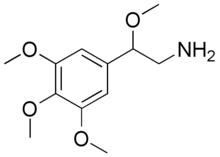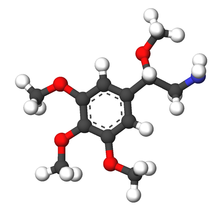This is the current revision of this page, as edited by KoIobok (talk | contribs) at 14:58, 23 March 2022 (Added Category:Phenylethanolamine ethers). The present address (URL) is a permanent link to this version.
Revision as of 14:58, 23 March 2022 by KoIobok (talk | contribs) (Added Category:Phenylethanolamine ethers)(diff) ← Previous revision | Latest revision (diff) | Newer revision → (diff)
| |

| |
| Names | |
|---|---|
| Preferred IUPAC name 2-Methoxy-2-(3,4,5-trimethoxyphenyl)ethan-1-amine | |
| Other names
3,4,5,beta-Tetramethoxyphenethylamine 2-(3,4,5,beta-Tetramethoxyphenyl)ethanamine β-methoxymescaline | |
| Identifiers | |
| CAS Number | |
| 3D model (JSmol) | |
| ChemSpider | |
| PubChem CID | |
| UNII | |
| CompTox Dashboard (EPA) | |
InChI
| |
SMILES
| |
| Properties | |
| Chemical formula | C12H19NO4 |
| Molar mass | 241.287 g·mol |
| Except where otherwise noted, data are given for materials in their standard state (at 25 °C , 100 kPa).
| |
BOM (3,4,5,beta-tetramethoxyphenethylamine) is a lesser-known psychedelic drug. It is the beta-methoxy derivative of mescaline. BOM was first synthesized by Alexander Shulgin. In his book PiHKAL, the minimum dosage is listed as 200 mg, and the duration unknown. BOM produces few to no effects. Very little data exists about its pharmacological properties, metabolism, and toxicity.
Legality
United Kingdom
This substance is a Class A drug in the Drugs controlled by the UK Misuse of Drugs Act.
See also
References
- BOM Entry in PiHKAL
- Shulgin, Alexander; Shulgin, Ann (September 1991). PiHKAL: A Chemical Love Story. Berkeley, California: Transform Press. ISBN 0-9630096-0-5. OCLC 25627628.
- "UK Misuse of Drugs act 2001 Amendment summary". Isomer Design. Retrieved 12 March 2014.
This psychoactive drug-related article is a stub. You can help Misplaced Pages by expanding it. |